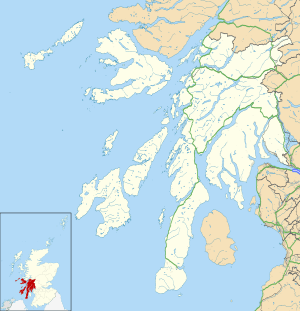Kennacraig
Kennacraig (Scottish Gaelic: Ceann na Creige) is a hamlet situated on West Loch Tarbert, a few miles south of Tarbert on the Kintyre peninsula, Argyll and Bute, in the west of Scotland.
Kennacraig
| |
|---|---|
 The Caledonian MacBrayne ferry MV Hebridean Isles arriving at Kennacraig. | |
 Kennacraig Location within Argyll and Bute | |
| OS grid reference | NR 82400 62130 |
| Council area |
|
| Lieutenancy area |
|
| Country | Scotland |
| Sovereign state | United Kingdom |
| Post town | TARBERT |
| Postcode district | PA29 |
| Dialling code | 01880 |
| UK Parliament |
|
| Scottish Parliament |
|
Ferry Terminal

Kennacraig to Islay ferry - geograph.org.uk - 127769
Caledonian MacBrayne ferries sail from the terminal, on the rocky islet Eilean Ceann na Creige, to Port Ellen or Port Askaig on Islay, and also to Colonsay during the summer season.[1]
Western Ferries started a car ferry to Islay from 7 April 1968[2] and CalMac took over in 1978, having previously used West Loch Tarbert.
| Preceding station | Ferry | Following station | ||
|---|---|---|---|---|
| Terminus | Caledonian MacBrayne Islay Ferry |
Port Ellen | ||
| Port Askaig |
gollark: The result is basically the same.
gollark: "Good"/"not very" why? It is very arbitrary.
gollark: There are also patents.
gollark: What? *All* thought is "abstract ideas" and you can copyright that.
gollark: Yes, it is an arbitrary distinction.
References
- "Kennacraig - Port Ellen / Port Askaig Crossing". Shipsofcalmac.co.uk. Retrieved 5 June 2015.
- "Islay Ferry - Past and Present". Islayinfo.com. 7 April 1968. Retrieved 5 June 2015.
This article is issued from Wikipedia. The text is licensed under Creative Commons - Attribution - Sharealike. Additional terms may apply for the media files.